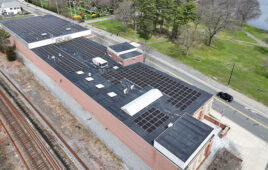From micro to P.O., central to string, solar inverters are getting more efficient. They’re getting smarter, too, with better monitoring capabilities, communication and even Wi-Fi. Manufacturers are also realizing it’s all about getting increased power density in leaner designs. We’ve listed a selection from each segment so you can compare models side by side and decide which is best for your project. This article is an extension of our Top 100+ Products feature in our 2013 December issue.
View top central and off-grid inverters here. View top string inverters here. View top solar modules here. (A-K) View top solar modules here (L-Z). View top sloped roof solar mounting solutions . View top solar canopies. View top solar ground mounts. View top solar technologies here. View top solar storage technologies here.
MICROINVERTERS
A Single Unit For Four Modules
The APS YC1000-3 is a single unit that connects four solar modules (up to 310W STC each) to provide from 208V to 480V 3-phase grid voltage. It maximizes power generation for each module to boost efficiency by up to 20%. The performance of each module can be individually monitored from a home computer.
APS America
apsamerica.com






Well, I am disappointed that no mention on which of these modules contain electrolytic capacitors. Enphase claims that electrolytics can last for over 20 years, but they depend on the capacitor manufacturer to encase the electrolyte (a liquid) in a capacitor case that will be subject to temperatures exceeding 140 F (60 C). Now do you believe that a liquid can exist in a metal “can” (with seams) at temperatures reaching 140 F for over 20 years? Yes, there is skepticism in your mind, just like in mine. And yes, the manufacturers that use electrolytics do offer a warranty, but that is like offering a warranty on house paint. Who really cares about the inverter (or the paint) itself? It is the pain of getting up on the roof, tearing out enough panels to get to the inverter that failed (yes, Murphy’s Law states that the one that failed is ALWAYS in the center of the array), getting the warranty paperwork done (yeah, they will require a solar company to come out, charge a diagnostic fee, & certify that the inverter failed), getting the new microinverter (if you have not already just said “frick it”, and bought a new, “probably not-compatible-with-the-old-ones” one), then re-installing it and re-installing all the panels you removed to access it, hoping not to have broken any (UV exposed) wires that are now probably obsolete and cannot be replaced. I am not yet ready to take the electrolytic capacitor plunge. I am disappointed that nothing was said here about this. Is this advertising or analysis? Come on, S.P. World, get with the program!
Andrew Ancel Gray
Andrew, I agree. After capacitor technology employed is the first thing we look at when evaluating module level electronics. (The next would be the daisy chain or trunk wire connector, because a connection that wiggles free is nearly as painful as a failed device)